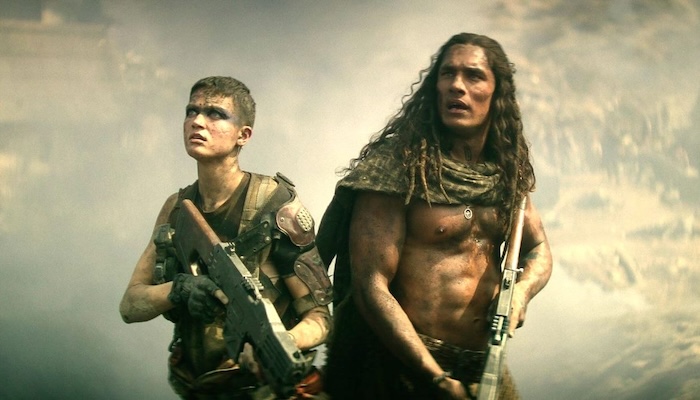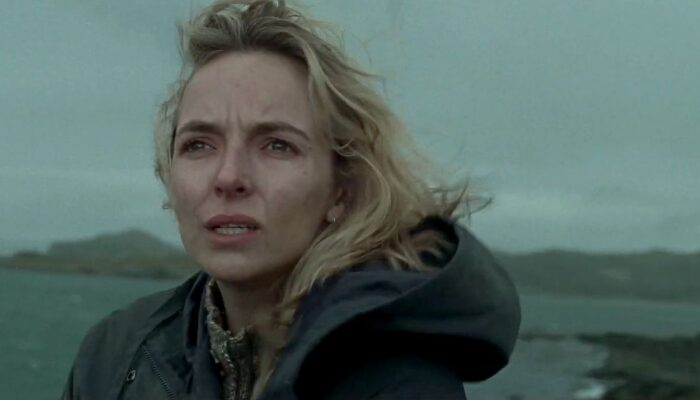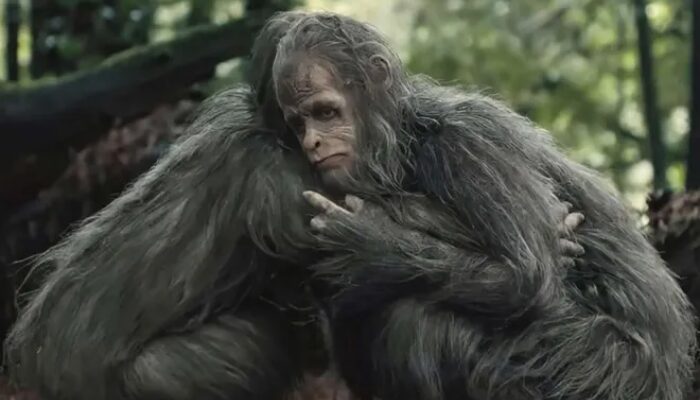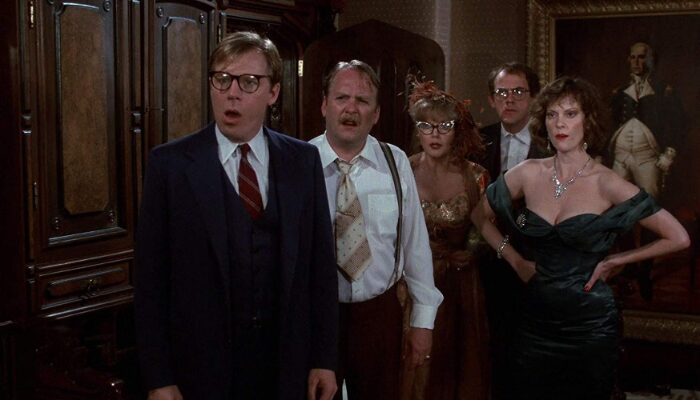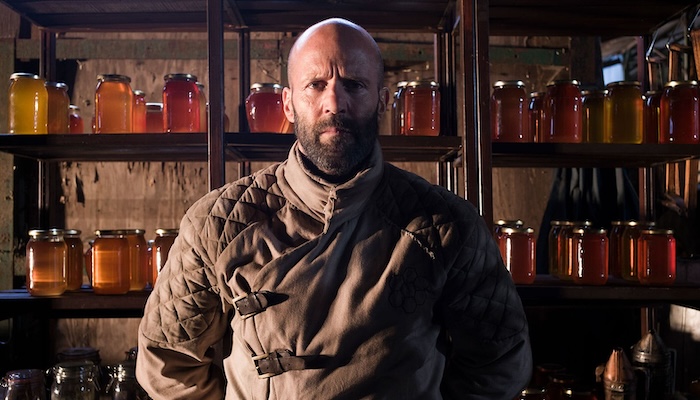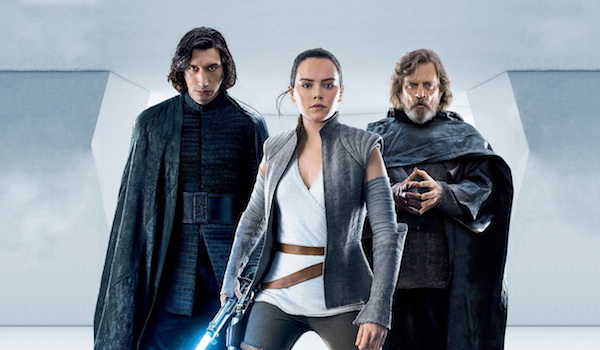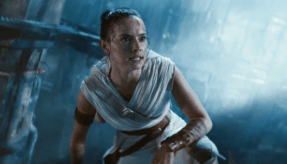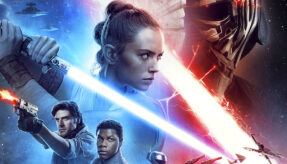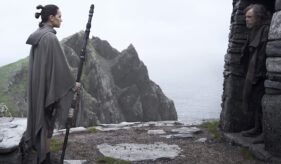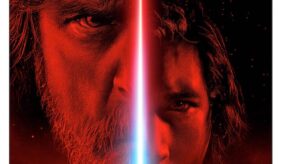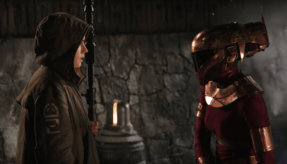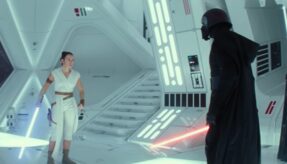Film Review: STAR WARS: THE LAST JEDI (2017): A Detrimental Film; Not Equal to its Predecessor
Star Wars: The Last Jedi Review
Star Wars: The Last Jedi (2017) Film Review, a movie directed by Rian Johnson, starring Mark Hamill, Daisy Ridley, Adam Driver, Laura Dern, Oscar Isaac, Carrie Fisher, Billie Lourd, Gwendoline Christie, Domhnall Gleeson, Benicio Del Toro, Andy Serkis, Gareth Edwards, John Boyega, Warwick Davis, Lupita Nyong’o, Peter Mayhew, Frank Oz, and Anthony Daniels.
Star Wars: Episode VIII – The Last Jedi was a disjointed film that did not equal or surpass its predecessor Star Wars: The Force Awakens. The Force Awakens was a far better film than The Last Jedi in terms of the new characters it introduced, its actions scenes, storyline (the first two-thirds), and the emotions expressed between characters.
The Last Jedi had two entertaining fight scenes (Luke Skywalker versus Rey, Red Guard vs. Rey / Kylo Ren), a large amount of humor, “okay” fight scenes (Phasma vs. Finn and all of the space / ground battles), “okay” plot-points, and an absurd overuse of CGI (the casino planet, the “horse” back-riding scene, and the All Terrain Scout Transport scene). The latter severely affected the George Lucas‘ prequel Star Wars films but what made them so stark in The Last Jedi is that its writer, Rian Johnson, should have known better and learned from the mistakes of the previous films. From what was on-screen during The Last Jedi, he hadn’t.
I have never attended the theatrical presentation of a Star Wars film and actually felt bored multiple times until The Last Jedi. During The Last Jedi, the viewer was waiting for the film to get great (or exquisite e.g. The Empire Strikes Back), to break through to that hallowed level of narrative quality and The Last Jedi never did. Most of the plot elements in The Last Jedi weren’t exploited to their full potential. It was like watching a missile that had decided to cruise at a safe altitude instead of tilting up, bursting into the upper atmosphere then exploding with fireworks the likes of which the movie-goer has never seen before or has been so long without they’d forgotten how good it could be (e.g. Blade Runner 2049). Instead, everything in The Last Jedi was bland, vanilla, and safe.
Numerous times throughout The Last Jedi, there were scenes that were reflections of scenes in previous Star Wars films minus those previous scene’s substance. Most notable of those scenes was when Rey was brought before Supreme Commander Snoke by Kylo Ren à la Luke Skywalker being brought before Emperor Sidious by Darth Vader in Return of the Jedi.
Unlike the latter scene, the underbelly in The Last Jedi scene was spurious, an implant to trick Kylo into thinking and behaving in a certain way. Besides that revelation, the scene was a standard betrayal and fight scene. It was not momentous like the scene it emulated because the same sub-textual work hadn’t been put into the substance of the scene.
One of the greatest, beneficial plot elements in The Last Jedi that was almost completely underutilized were the other Jedi-in-training that Ben Solo / Kylo Ren (Adam Driver) absconded with after destroying Luke Skywalker’s Jedi Temple. Outside of the Jedi-in-training turned Red Guard’s incessant Versus-like posing and distinctive weaponry, they had zero character development and no personalities. It was exactly the same problem that afflicted the characters in Rogue One: A Star Wars Story i.e. because they were all going to die, the screenwriter erroneously thought that the Red Guard needed no characterization whatsoever.
There were so many empty, throwaway scenes in The Last Jedi that one of them could have been cut and another added where all of the Red Guard were in a room with Kylo, speaking to one another (or receiving orders), with none of them wearing their helmets.
The most egregious aspect of the Red Guard was that they were written as neophyte swordsmen. Why would the military place people so unskilled as guards to the most important person in their government? The Red Guard had been trained with using The Force and swordplay for years. Rey had only been training for weeks. Even with Rey’s staff fighting ability, the Red Guard should have mopped the floor with her.
Ninety-nine percent of the micro-fights during the Rey vs. Red Guard scene weren’t even close and they should have been, for reality’s sake and for increased tension, creating a scene where something was actually at stake. From its outset, nothing was at stake during the fight and it contained no subtext. The fight was all flashy moves and an inexorable victory. If you are so much better than your opponent and they never stood a real chance, what was the point of the fight scene?
The Red Guard vs. Rey / Kylo Ren fight scene in The Last Jedi was supposed to be one of the film’s marquee moments but the lack of skill, precision, swiftness, and cunning on the part of the Red Guard made it unrealistic, especially when it came to Rey, even when one considers her evidenced and (somehow) inherent prowess with a laser sword.
At the end of the Red Guard vs. Rey / Kylo Ren fight, the questions that had been raised before the fight and during it lingered: Why did Kylo turn on Supreme Leader Snoke (Andy Serkis) and the Red Guard? Did he not calculate that Rey might not join him and that he would be killing his master and fellow former students for nothing? And why would Rey take Kylo’s hand and join him? He had just killed everyone, with Rey’s help, that had joined him in the past. The past might repeat itself a second time with her when she least expected it. Why would she put herself in that position?
Kylo Ren’s assumptions and rationalization were completely flawed. His own actions with Rey killed the reality that he sought to forge.
The Force-to-Force mind link between Rey and Kylo, introduced in The Last Jedi, was the best story element of the film. It added something new and beneficial to the Star Wars universe that existed in no other film. It was extremely interesting to see Kylo’s anger subside, his guard lowered, as he let Rey get to know a small piece of himself. The problem with the link is that the writer wrote it as one-sided. Rey got to know Kylo and a significant event in his past but there was no exploration of Rey’s past. That was flaw in this section of the film. The identity of Rey’s parents did not have to be revealed but there was more to Rey than abandonment, scavenging, and The Force. Some of that coming into play would have made the Force-to-Force mind link even more powerful, not just in terms of resonance between Rey and Kylo Ren but for the film in general.
A question: If Supreme Commander Snoke created and sustained the Force-to-Force mind link, how was the link still present after Snoke was killed?
Another question during The Last Jedi was why the possible budding romance between Rey and Finn was terminated. From the moment Finn looked up at Rey in The Force Awakens, the viewer could see he was attracted to her. It was obvious and hilarious (all of the things he did to earn and keep her favor while staying in her presence as much as possible). In The Last Jedi, the first thing that Finn thought about and spoke of was Rey. With all of that in mind, how does a new girl supplant the amorous feelings that Finn felt towards Rey, especially after all he and Rey had been through together? Rose Tico (Kelly Marie Tran)’s kiss was sweet, sincere, and dramatically timed but was minuscule in the face of Rey’s emotional and physical dominance within Finn’s mind (the mind controls the body after all). How many times had Finn thought about kissing Rey, holding Rey in his arms, etc.? The hope of romance between Finn and Rey had not been extinguished when Rose kissed Finn. In point of fact, the possibility hadn’t been broached or explored by Finn. The Last Jedi would have the viewer believe that Finn would throw away those hopes, feelings, and unrequited acts for a nearly complete stranger that he’d met a day ago. This was an extremely hard plot point to accept and digest but it was no orphan in The Last Jedi. There were many other plot points in The Last Jedi of that pedigree.
The ticking clock in The Last Jedi, in the form of a First Order armada chasing the last vestige of the Rebel fleet, was absolutely terrible. The worst part is that the scene, interspersed with other scenes, kept going and going. Drama happened in both fleets during the ticking clock and none of it made that plot device worth its inclusion in The Last Jedi. In general, the ticking clock is a good plot device, used to brilliant effect in previous Star Wars films, but used extremely poorly in The Last Jedi. If you are going to recycle a plot device, do it well. Critics bemoaned the Death Star rehash in The Force Awakens‘s third act but that “recyclying” was written and executed with a far more narratively-deft hand than in this film. Remember when I spoke of boredom earlier? The ticking clock in The Last Jedi was its largest contributor.
The same could be said about the empty Captain Phasma (Gwendoline Christie) vs. Finn fight in The Last Jedi (pure fan service, its creation and inclusion in the film obvious wish-fulfillment).
During the fight scene with Finn, the combat skills presented by Captain Phasma were pathetic. How does a female Stormtrooper rise to the rank of Captain yet be so skill-less that they are beaten by a soldier formerly relegated to garbage detail? It was inexplicable that Captain Phasma lost that fight. It was ridiculous that Finn was even able to hold his own against her. Think of all the combat experience a veteran soldier like Phasma would have had to utilize and fall back on. How did a seasoned soldier like that fail to beat and kill someone who amounted to a rookie in comparison? Hubris? No. Worse. The Last Jedi‘s screenwriter. Captain Phasma was handicapped by her writer and forced to lose. The viewer could feel it as they watched the cartoon fight unfold.
During The Last Jedi, Luke Skywalker, General Leia Organa (Carrie Fisher), and Yoda (Frank Oz)’s new powers were exciting to witness but they created more problems for the narrative of the film and the Star Wars universe than they solved.
Why didn’t Luke physically go to Crait and kill Kylo Ren instead of astral projecting himself to Crait? Did Luke not have enough time to get from Point A-to-Point B before it was too late?
How did General Organa’s human body withstand temperatures of minus-270 degrees Celsius within the void of deep space? She would have been frozen solid almost instantly without a space suit.
How did Yoda make a storm cloud shoot a bolt a lightning exactly where he wanted it?
As I said, those were exciting moments but had no basis in Star Wars-lore. That is not a bad thing, on the contrary, new things should be added, like The Force-to-Force mind link, instead of relying on the old but not when it hurts what came before it. Example: if a Force user’s body could defeat the deep cold of outer space, why couldn’t a Force user’s body defeat a laser sword’s heat (e.g. Qui-Gon Jinn and how he died in The Phantom Menace). That inconsistency hurt Star Wars and its mythos, it didn’t ameliorate it.
Then there were moments that should have been completely deleted or changed in The Last Jedi.
How do bombs “drop” in outer space, where there is no gravity? Even if there was artificial gravity inside of the bombers at the beginning of The Last Jedi, once outside the ship, how did the bombs continue “dropping”?
Why create a war ship where its canons need to charge before being able to fire? Haven’t First Order scientists and military engineers learned from their previous mistakes? Don’t they play back and analyze war footage and previous strategies?
If the Red Guard weren’t the Jedi-in-training that Ben Solo took with him after he destroyed the Jedi Temple, why weren’t they armed with Blasters and long rifles? One assumes that if they weren’t those former Jedi-in-training, that they were elite soldiers i.e. high-end Stormtroopers. If that is the case, why were they only armed with hand-to-hand combat weapons?
If Luke Skywalker could directly look into the mind of Ben Solo and see that he had already been corrupted, why couldn’t or didn’t other Jedi (e.g. Mace Windu) look directly into the mind of Anakin Skywalker when questions of Anakin’s temperament and loyalty were raised in Revenge of the Sith? Anakin was surrounded by intuitive, master Jedi and no one, including the Jedi suspicious of him, looked into his mind. Why?
It was plot points of this deleterious quality that made Star Wars: The Last Jedi grind against its own best intentions, harming the scenes in question and the Star Wars narrative as a whole. The telephone commercial that began The Last Jedi (“Can you hear me now?”) was an inappropriate and off-putting harbinger of what was to come in the film.
For all of its dubious plot points, explosions, revelations, and various battles, Star Wars: The Last Jedi was an average science fiction film. There was nothing special about it. The film played out and then it ended, with the viewer asking themselves “Why me?” instead of being filled with wonder and awe as they got up from their movie theater seat.
Rating: 5/10
Leave your thoughts on this Star Wars: The Last Jedi review and the film below in the comments section. Readers seeking more film reviews can visit our Movie Review Page, our Movie Review Facebook Page, and our Movie Review Google+ Page. Want up-to-the-minute notifications? FilmBook staff members publish articles by Email, Twitter, Tumblr, Google+, and Facebook.
Related Articles
FilmBook's Newsletter
Subscribe to FilmBook’s Daily Newsletter for the latest news!

